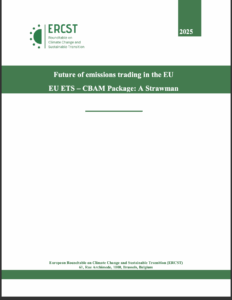
- This event has passed.
EU ETS: Impacts of the new clean energy package targets on the MSR
The Market Stability Reserve was put in place to address the current surplus of EUA’s in the market, as well as “normal” levels of surplus that may emerge in future years. The performance of the MSR is therefore critical to the well-functioning of the EU ETS. However, the parameters have not been tested in real life, and many were put in place a while ago, especially the thresholds. As the MSR starts to operate, monitoring its parameters and their fit with the current environment is important.
Policies that support the deployment of renewable energy sources (RES) and the improvement of energy efficiency (EE) will continue to drive emission reductions in the EU, effectively ‘overlapping’ with the EU ETS, and ultimately limiting its role as a driver for decarbonization. The recently agreed targets of the 2030 EU Energy package (32% for renewables and 32,5% for energy efficiency) will certainly lead to additional CO2 reductions in EU ETS sectors and will further impact the supply- demand balance in the market.
Therefore, in spite of the doubling of its withdrawal rate until 2023, the MSR may not, under certain conditions, be able to mitigate the impact of those policies on the EU ETS during Phase IV.
The MSR reviews scheduled in 2021 and 2026 will be key to assess the accuracy of its parameters to mitigate ex-post the effects of overlapping policies on the EU ETS which targets have been significantly reinforced last June.
Questions to be discussed during this meeting
- The MSR parameters were adjusted a while ago but we are currently facing a new situation – whatare developments that need to be taken into account in light of the review cycle? (e.g. new targets for EE and RES; changes in economic growth and forecasts for the future; new provisions for the 4thPhase adopted this year, etc.)
- How will this new context influence the behaviour of players on the ETS market and to what extent will the MSR, with its current parameters, be able to remove future unexpected unbalances (e.g. impact on the evolution of the carbon price, etc.)
- What are possible changes in hedging behaviour? If significant changes occur, what impact will it have on the market?
- How should proposals to modify the MSR design be analysed and judged? What should be changed to ensure the MSR is resilient?
Workshop Materials:
Agenda
Presentation by ERCST
Präsentation by S. P. Schleicher
Presentation by T. Buckley
Presentation by R. Trotignon
Presentation by J. Ackva
Presentation by P. Ruf
Related Events
Product Standards in the EU – Stakeholder consultation
January 12 @ 14:30 - 16:30Stakeholder Roundtable: 2026 State of the EU ETS Report
January 13 @ 10:00 - 12:00Focus Group: EU CBAM Legislative Proposal
January 13 @ 15:00 - 16:30Stakeholder consultation- EU’s Road Transport Decarbonization Policy: Innovative Policy Approaches for Industrial Competitiveness
January 15 @ 14:30 - 16:30Debate – Industrial Decarbonisation Accelerator Act: will it be the signal for hydrogen demand to emerge?
January 22 @ 15:00 - 17:00
Discussion – Public consultation on CO2 markets and infrastructure
December 16 @ 10:00 - 11:30Launch event – Towards a comprehensive hydrogen infrastructure – Assessing progress and addressing gaps
December 11 @ 15:00 - 17:00Launch Event: EU ETS – CBAM Strawman Report
December 9 @ 10:00 - 12:00

